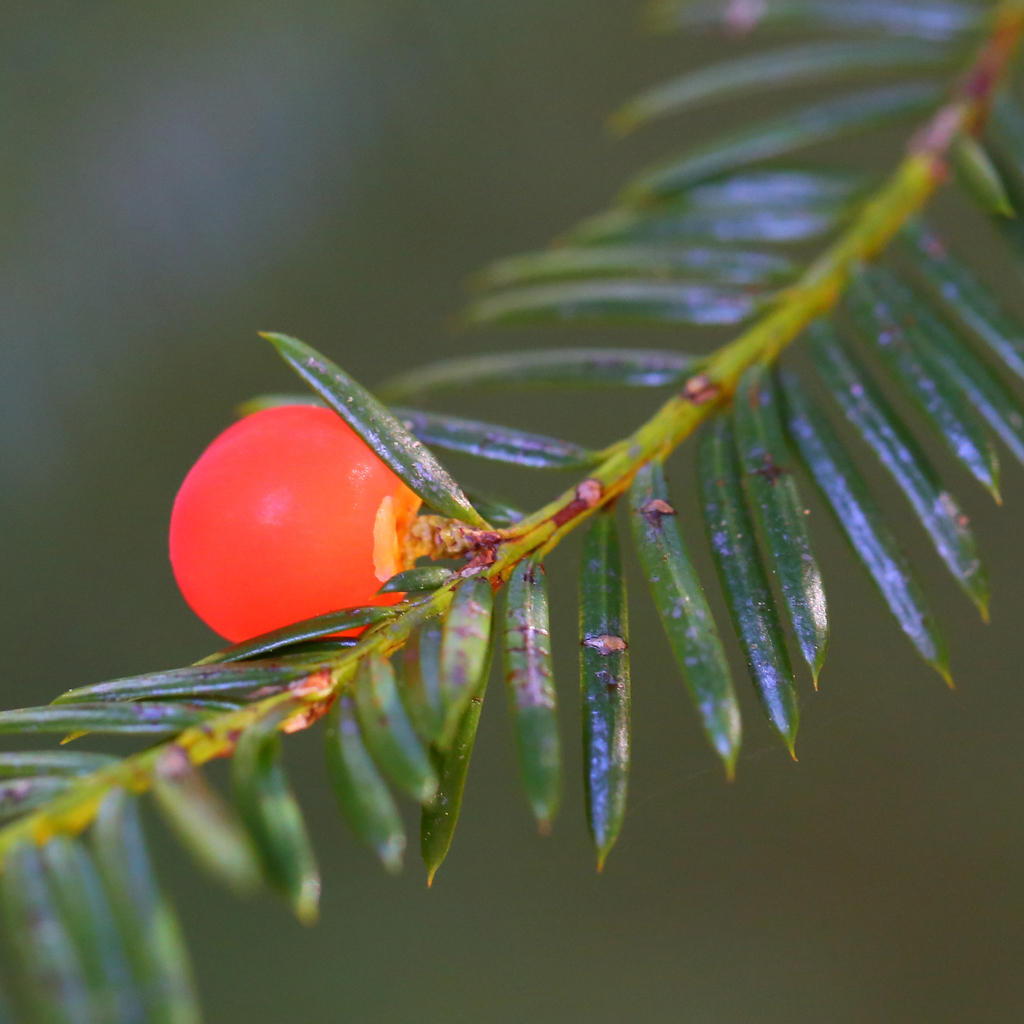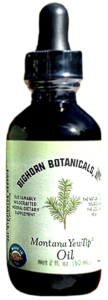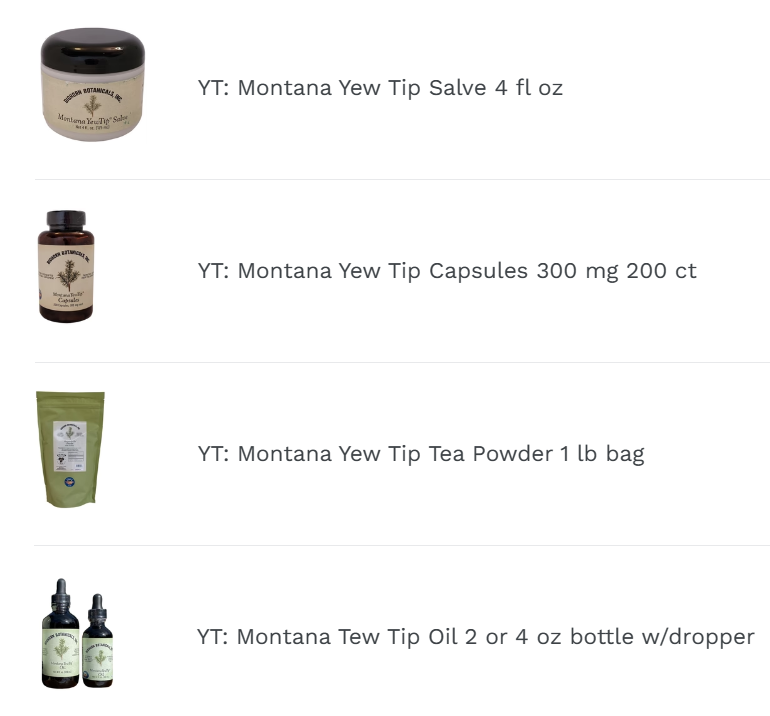Anticancer & Antiparasitic Montana Yew Tips for Regeneration
Recently rediscovered Montana Yew Tip was harvested and studied by a pharmaceutical company looking to exploit these naturally occurring bioactive compounds to treat cancer patients. The incredible power of this plant exterminator of pathogens and regenerative qualities was nothing new to the Northwest Native Americans who have used Montana Yew Tips as medicinal botanicals and natural dietary supplements.
Indigenous tribes and their healers used preparations from the Yew tree to treat internal and external ailments, illnesses, and injuries, long before the pharmacological scientific “discovery” of these compounds. Proprietary scientific research was abandoned once the pharmacological entity was able to patentably synthesize it in the laboratory.
Anticancer Montana Yew Tip
Montana Yew Tip stands out for its potential anticancer properties, offering hope and inspiration in the fight against this formidable disease. Derived from the taxus brevifolia tree, commonly referred to as Montana Yew, Western Yew, or Pacific View indigenous to Northwestern Montana and Northern Idaho. Montana Yew Tip has been revered for centuries by Native Americans for its therapeutic benefits, including its purported ability to combat cancer.
Montana Yew Tip contains several bioactive compounds which have been studied for their anticancer effects. These compounds exhibit remarkable properties that interfere with cancer cell growth and proliferation, induce apoptosis (programmed cell death), and inhibit angiogenesis (the formation of new blood vessels that support tumor growth). Additionally, Montana Yew Tip demonstrates anti-inflammatory and immunomodulatory properties, further enhancing its potential as a holistic approach to cancer treatment and prevention.
Beyond the cancer-fighting properties of Montana Yew Tips an enormous amount of data has surfaced from historical Native American documentation which so highly regarded the Montana Yew tree calling it the, “Chief of the Forest,” used to treat scurvy and a vast number of ailments. A current list of ailments and diseases where Montana Yew Tip has proven efficacy include,
- Abrasions
- Allergies
- Arthritis
- Basal cell carcinoma
- Bronchitis
- Brucellosis
- Burns
- Bursitis
- Candida
- Candidiasis (a vaginal or oral yeast infection)
- Chemo side effects
- Chronic fatigue syndrome
- Colitis
- Coxsackieviruses
- Cuts
- Dental infections
- Diaper rash
- Digestive problems
- Disease-causing inflammation
- Ear infections
- Fighting infection
- Gonorrhea
- Healing accelerant
- Hemorrhoid
- Hepatitis A, B, C
- Herpes viruses
- Influenza
- Insect bites
- Irritable bowel syndrome
- Leaky gut syndrome
- Liver problems
- Leprosy
- Lupus
- Malaria
- Melanoma
- Meningitis
- Norovirus
- Osteoarthritis
- Parasites
- Pneumonia
- Prostate issues and cancers
- Psoriasis
- Rheumatism
- Sarcomas
- Scar reduction
- Schistosomiasis
- Shingles
- Skin cancer
- Skin disorders
- Tuberculosis
- Tumors
- Ulcers
- Urinary problems
- Urinary tract infections
Antiparasitic Montana Yew Tips
Montana Yew Tip emerges as a potent ally in the battle against parasitic infections. Montana Yew Tip has been cherished for centuries for its therapeutic benefits, including its remarkable antiparasitic properties. As parasitic infections continue to pose health challenges globally, understanding how to harness the antiparasitic potential of Montana Yew Tip holistically offers promising avenues for health and well-being.
Parasites are organisms that inhabit and feed on a host organism, usually at the expense of that organism. Parasitic infections are incredibly common, though they are not often considered as causative factors for illness.
Many different types of parasites can infect humans. While Montana Yew Tip appears to have some general antiparasitic properties, studies suggest that it is particularly beneficial for eliminating liver flukes, a parasite that people can get by eating raw or undercooked fish or shellfish. Montana Yew Tip has also been used for hookworm and tapeworm infections.
While Montana Yew Tip has some antiparasitic properties, it is not traditionally known to be the most effective antiparasitic for a broad range of parasitic pathogens.
Montana Yew Tip bioactive compounds work by interfering with the growth and reproduction of various parasites, including protozoa and worms. Additionally, Montana Yew Tip exhibits anti-inflammatory and immune-modulating properties, further enhancing its potential as a holistic remedy for parasitic infections.
By integrating Montana Yew Tip into your holistic health regimen, you can tap into its antiparasitic properties and empower your body’s innate ability to fend off parasites.
Additionally, Montana Yew Tip is
- Antibacterial
- Anticancerous
- Anticandidal
- Antifungal
- Anti-inflammatory
- Antileukemic
- Antimalarial
- Antitumorous
- Antiviral
Utilizing Montana Yew Tips in your holistic health routine can be approached through diverse methods, each offering unique advantages in supporting alternative treatment modalities and overall wellness:
Herbal Tea Infusion: Brewing Montana Yew Tips into a tea is a popular and accessible method. Simply steep one to two teaspoons of dried Montana Yew Tips in hot water for 10-15 minutes. Regular consumption as part of a comprehensive support protocol is recommended.
Topical Applications: Montana Yew Tip can be applied externally to treat skin infections, wounds, or fungal conditions. Dilute Montana Yew Tip tea or tincture with water and apply it to the affected area using a clean cloth or cotton ball, several times a day as needed.
Tinctures and Extracts: Available in tincture or extract form, Montana Yew Tip can be easily added to water or juice for consumption. Follow the dosage instructions provided for optimal results.
Supplementation: Montana Yew Tip is also available in supplement form, including capsules or liquid extracts, offering a convenient way to incorporate it into your daily routine.
Skin Soothing Treatment: Apply diluted Montana Yew Tip tincture to fungal skin infection rashes for relief and healing of discomfort.
Nutritional Support: Consider integrating Montana Yew Tip tea or supplements alongside a balanced diet rich in whole foods to maximize therapeutic benefits and support overall health and immune function.
Complementary Therapies: Integrating Montana Yew Tip with complementary therapies like acupuncture or meditation can enhance well-being and promote the body’s natural healing mechanisms.
Ways to Incorporate Montana Yew Tip
Daily Ritual: Begin your day with a cup of Montana Yew Tip tea to set intentions for healing and vitality.
Meal Enhancement: Add liquid Montana Yew Tip extract to smoothies or soups for additional health benefits.
Foot Soak: Treat athlete’s foot and soothe tired feet with a foot soak using Montana Yew Tip tea.
Relaxation Practice: Pair mindfulness or yoga sessions with a soothing cup of Montana Yew Tip tea to promote relaxation and stress reduction.
Precautions and Considerations
While generally safe when used appropriately, it’s important to consult with a healthcare professional before integrating Montana Yew Tip into your treatment plan, especially if undergoing chemotherapy or other conventional therapies. Individuals with certain medical conditions or those taking medications should exercise caution and seek guidance.
Conclusion
Montana Yew Tip offers a holistic approach to health support, complementing conventional treatments and promoting overall well-being. By integrating it into a comprehensive health regimen, individuals can tap into its potential benefits. However, mindful usage and consultation with healthcare providers are essential. Montana Yew Tip stands as a symbol of hope in the realm of natural remedies, reminding us of the healing potential found in nature’s embrace.




